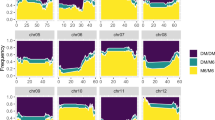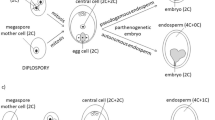Abstract
All members of Rosa section Caninae, dogroses are polyploid and characterized by their unbalanced meiosis, which in most cases leads to a pronounced morphological influence from the maternal parent. In a previous investigation on a pair of reciprocal crosses between two species in this section, Rosa dumalis and R. rubiginosa (2n=35), nine offspring plants (approximately 10%) did not receive any of the 21 RAPD markers present in the respective pollen parent. This was interpreted as a possible occurrence of apomixis. These nine plants have now been subjected to a further study with additional markers. Thirteen new RAPD markers showed the same result as in the previous investigation: none of the nine plants inherited any of the pollen donor markers. The reproducibility of the RAPD markers was checked by mixing DNA samples to obtain a series of artificial hybrids between the two parent plants. Twelve RAPD markers gave the expected result, whereas one marker appeared only 50% of the time. In addition, pollen viability, mean number of seeds per hip, mean seed weight, and mean weight of fruit flesh per hip have been studied on the four progeny groups: R. dumalis×R. rubiginosa plants which received pollen donor markers (PM plants), R. dumalis×R. rubiginosa plants which did not receive any pollen donor markers (NPM plants), R. rubiginosa×R. dumalis PM plants and R. rubiginosa×R. dumalis NPM plants. A canonical discriminant analysis based on these four reproductive characters separated the four progeny groups. There were significant differences between the two PM groups in all investigated characters, and also between the PM and the NPM groups in pollen viability. The result from the RAPD markers together with the differences in pollen viability between the PM and NPM progeny groups is taken as an indication that apomixis occurs within the Caninae section.
Similar content being viewed by others
Author information
Authors and Affiliations
Additional information
Received: 13 October 1999 / Revision accepted: 28 January 2000
Rights and permissions
About this article
Cite this article
Werlemark, G. Evidence of apomixis in hemisexual dogroses, Rosa section Caninae . Sex Plant Reprod 12, 353–359 (2000). https://doi.org/10.1007/s004970000028
Issue Date:
DOI: https://doi.org/10.1007/s004970000028




